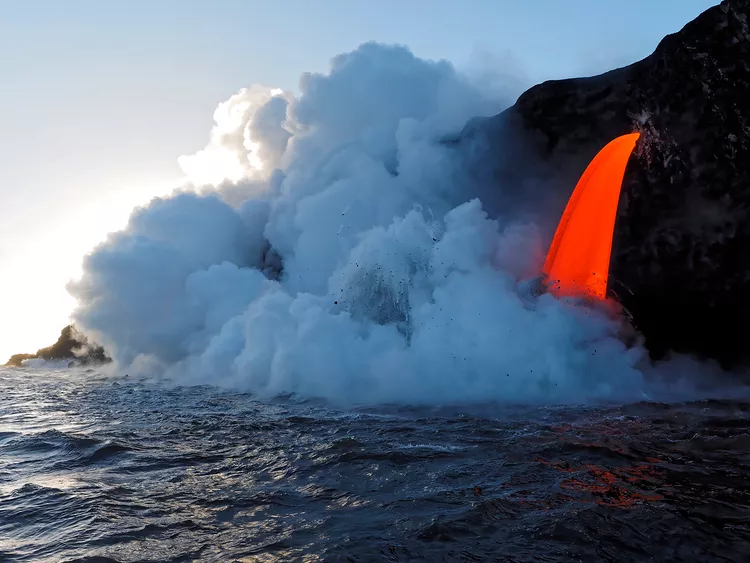Summary
1. Formation of the Big Island
2. Hualalai Volcano
3. Kilauea Volcano
4. Kohala Volcano
5. Mauna Kea Volcano
6. Mauna Loa Volcano
Formation of the Big Island of Hawaii
The Big Island of Hawaii was formed entirely by volcanic activity. There are five separate volcanoes which have, over the past million-or-so years, combined to form the island. Of these five volcanoes, one is considered to be extinct and in transition between its post shield and erosional stage; one is considered dormant, and the three remaining volcanoes are active with Kilauea volcano being the most dangerous.
Despite the destruction of over 700 homes, reports of injuries from lava bombs spewing from Kilauea, and ongoing eruptions and lava flows, the Big Island remains safe for travelers. However, visitors must take proper precautions. Boat tours, cruise lines, and airlines have modified their schedules and routes when necessary. Therefore, travelers are cautioned to stay updated on the news regarding the active Kilauea volcano and avoid affected areas accordingly.
Hualalai Volcano

Address
Hualālai, Hawaii 96725, USA
Hualalai, located on the western side of the Big Island, is the third youngest and third-most active volcano on the island. The 1700s marked significant volcanic activity with six different vents erupting lava, two of which produced flows that reached the sea. The Kona International Airport was constructed atop the larger flow from this period.
Notably, despite much construction on the slopes and flows of Hualalai, it is anticipated that the volcano could erupt again within the next century.
Kilauea Volcano

Address
Kīlauea, Hawaii 96778, USA
Once thought to be an offshoot of its large neighbor, Mauna Loa, scientists now understand that Kilauea is a separate volcano with its own magma plumbing system, extending to depths of over 60 kilometers (over 37 miles) into the earth.
Kilauea, situated on the southeast side of the Big Island, is one of the most active volcanoes globally. Major eruptions began in January 1983, continuing to this day. The volcano has inflicted considerable property damage, notably leading to the destruction of the town of Kalapana in 1990, as well as Vacationland Hawaii in more recent years. The Lower Puna eruptions that commenced in May 2018 opened numerous lava vents in Puna, causing significant evacuations due to a 6.9 earthquake on the Richter scale.
These eruptions have resulted in devastating lava flows, obliterating a historic 700-year-old Hawaiian temple (Wahaʻula heiau), ruining various housing subdivisions, and obstructing key highways.
Alongside Mauna Loa, Kilauea is part of Hawaii Volcanoes National Park. However, due to the recent eruptions, some sections of the park have experienced closures and reopening of areas, including the Kilauea Visitor Center, which reopened in September 2018. Visitors should remain prepared for unannounced closures.
Moreover, the fissures and lava flows have spread beyond the national park’s boundaries. Travelers are advised to exercise caution; natural disasters have compromised roadways, and it is critical not to disregard roadblocks put in place by officials for safety.
There are currently no signs indicating that the volcanic activity will cease anytime soon.
Kohala Volcano

Address
Kohala, Hawaii 96743, USA
Kohala Volcano is the oldest volcano on the Big Island, having emerged from the sea more than 500,000 years ago. An enormous landslide over 200,000 years ago resulted in the loss of the northeast flank, creating the dramatic sea cliffs prominent in this area. Over time, the height of the summit has diminished by over 1,000 meters (more than 3,280 feet).
Over the centuries, Kohala has gradually sunk, and lava from its larger neighbors, Mauna Kea and Mauna Loa, has covered the southern portion of the volcano. Consequently, Kohala is now classified as an extinct volcano.
Mauna Kea Volcano

Address
Mauna Kea, Hawaii 96720, USA
Mauna Kea, meaning “White Mountain” in Hawaiian, is the tallest of Hawaii’s volcanoes. In fact, it is the tallest mountain in the world when measured from the ocean floor to its summit. The summit is occasionally snow-capped, sometimes reaching significant depths.
The summit of Mauna Kea hosts numerous observatories, making it an ideal location for stargazing. Several tour companies offer trips to the summit during the evening for sunset views followed by nighttime star observations.
The Onizuka Center for International Astronomy, located near the summit, provides insights into the history of the mountain and the research conducted by the observatories.
Here, Mauna Kea is classified as a dormant volcano, having last erupted around 4,500 years ago. Nevertheless, it may erupt again in the future. The intervals between eruptions at Mauna Kea are lengthy compared to those of active volcanoes.
Mauna Loa Volcano

Address
Mauna Loa, Hawaii 96785, USA
Mauna Loa is recognized as the second youngest and second-most active volcano on the Big Island and also holds the title of the largest volcano on earth. Extending northwest to Waikoloa, covering the entire southwest of the island, and reaching east near Hilo, Mauna Loa poses a significant volcanic threat with potential eruptions in various directions.
Historically, Mauna Loa has erupted at least once per decade throughout recorded Hawaiian history. However, since 1949, the frequency of eruptions has decreased, with notable eruptions in 1950, 1975, and 1984. Consequently, scientists and residents of the Island of Hawaii continuously monitor Mauna Loa in preparation for its next eruption.





